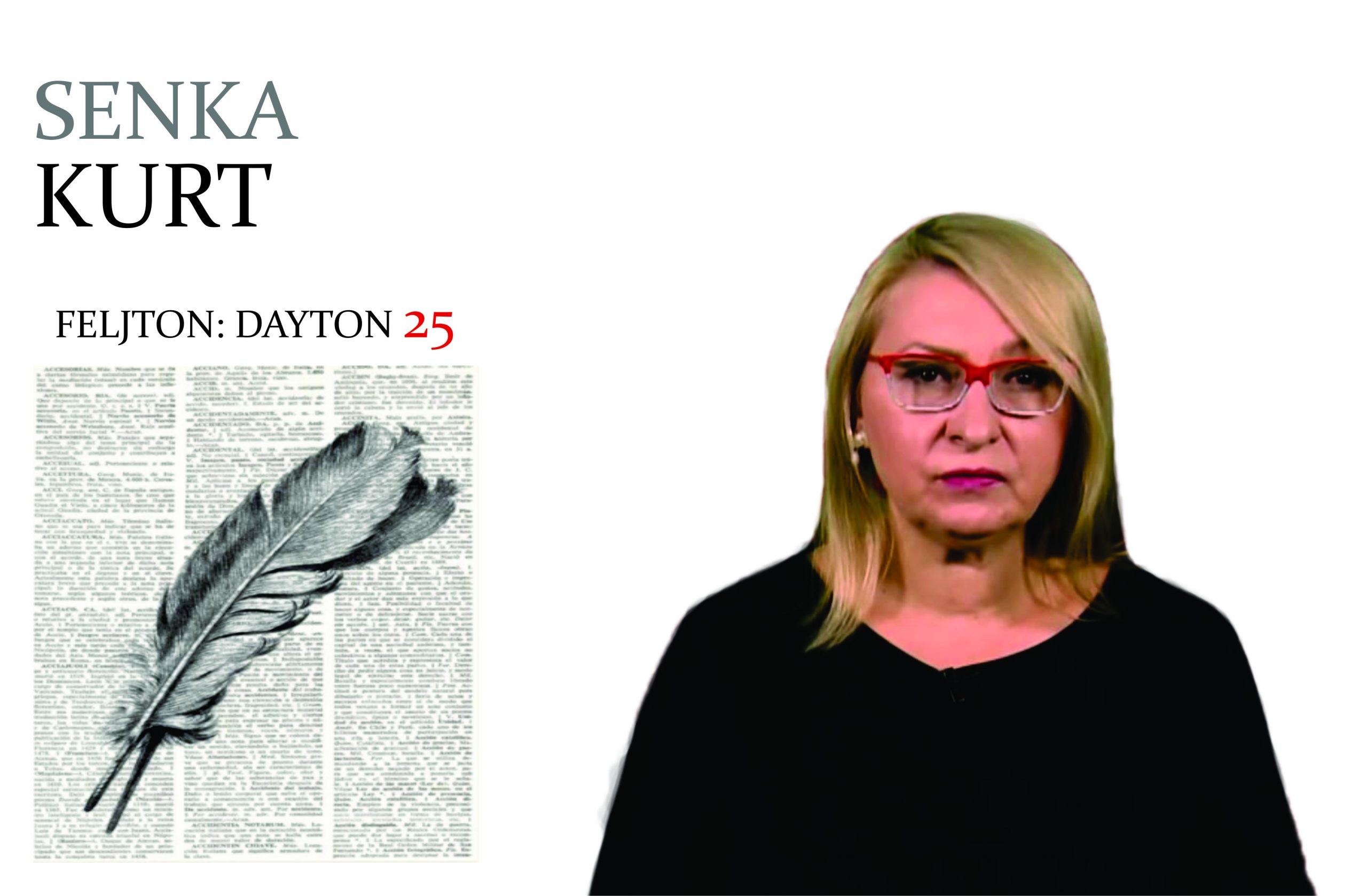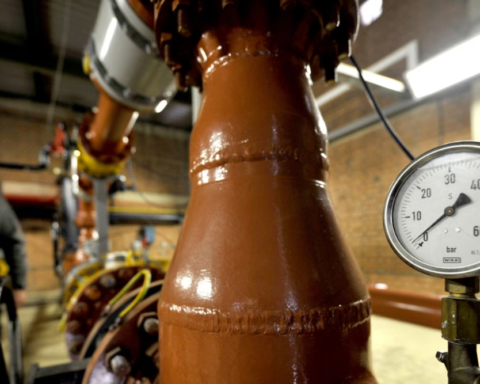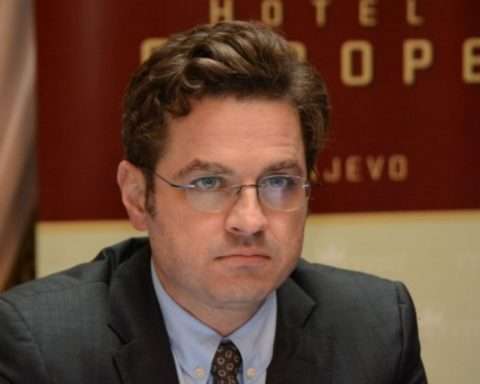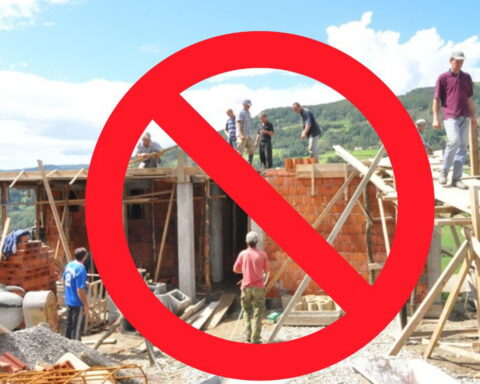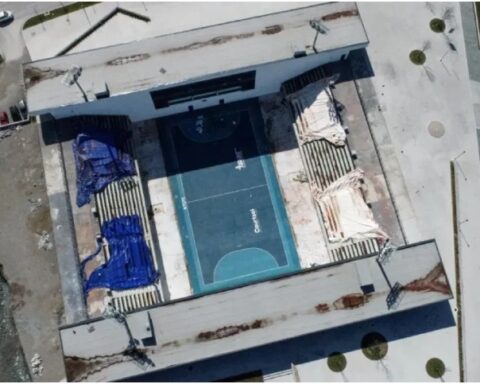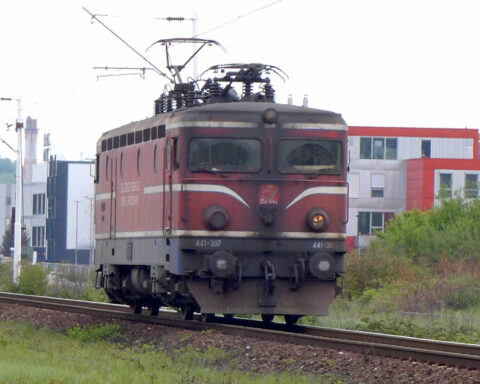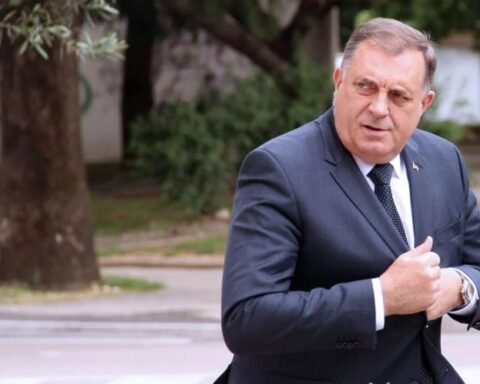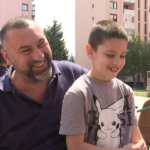Amazingly, at one point the parties would stare at each other across the table yelling, while a minute later you would see them laugh and joke over the service. This is the simplest and shortest description of what happened during the negotiations at the Wright Patterson base.
Author: Senka Kurt for Interview.ba
When only a few days later, after the Peace Agreement was signed in Dayton, the BH. delegation, led by the Chairman of the Presidency of BiH, Alija Izetbegović, returned to Sarajevo, the journalists could hardly wait for their five minutes.
During the almost three-week negotiations at the Wright-Patterson military base, information was hardly coming to light. However, we will find out later that the agreement was just like that. Only American negotiators had the right to present the information, and we had to manage as we knew and as we were able to. It was a time when telephone connections from Sarajevo were a rarity, and we didn’t even dream about mobile phones or e-mail. From the city, which was under siege for three and a half years, it all looked like science fiction.
When we finally welcomed the meeting with the BH. delegation in the building of the Presidency of BiH, we knew almost all the facts, which were important at that time. Peace has been signed, annexes agreed, weapons are silent, now comes the hardest part. Starting a normal life.
However, one question, which was asked to Alija Izetbegović at the press conference by the former editor of “Dani”, Senad Pećanin, opened new dilemmas.
Senad asked Izetbegović what is BiH today, after Dayton. Most looked at Pećanin wondering why did he ask the question. So when a very unconvincing answer arrived, which was actually an explanation of what was done in Dayton, I asked a question too.
– Mr. Izetbegović, what are we now, what is our state system – republic, federation, confederation, union – I wanted to know.
I have not received an answer to this day.
By the way, I remember that famous November 21, 1995, because of my nervousness. And disappointment. That very evening, the famous band Laibach was about to hold their first concert at the National Theatre and present the artistic and political project of the „NSK State of Sarajevo“. I was looking forward after so many war years, to any concert, and this one in particular. I had lived in that restless euphoria for days. However, in the afternoon of that day, it was suspected that I would not even step into the theatre. News began to arrive from Dayton that it was time for the “judge to sound the end”, that is, for Richard Holbrooke, the American peace mediator, how he is affectionately called and the “architect of Dayton” to announce – it’s over, peace has been signed. The agreement was that the news from the Rose Garden would be announced to the world by the former US President Bill Clinton.
How I waited for soldiers on tanks and girls throwing flowers
I am staying newsroom, I am on the phone on all sides, I call the members of our delegation, I miraculously get Muhamed Šaćirbegović, who was the head of BH. diplomacy until the day before the signing. I also get Haris Silajdžić, the head of BH. Government. I don’t hear any euphoria in their voice. World agencies publish bombastic headlines. I look at my watch and it is already clear to me – nothing from the concert.
I remember going to the former hotel „Belgrade“ later. During the war, it was named “Bosnia”. Foreign reporters from Sarajevo celebrated. Champagne was also opened. Everyone was euphoric and joyful. Us locals looked pale. Nothing was clear to us.
I am a Tito’s pioneer and every Sunday as a child I waited for the TV show “Let us speak” to start, about the activities of “our JNA”, after which a partisan film would be played. This is how I watched those glorious war cut-offs. When soldiers enter the city on tanks, and girls and women cry and throw flowers at them.
I admit, I thought it would be the same this November of 1995. They would say on the BBC that this was a “unique end to the war”.
The fight for peace, which, we will know, will be “unfair” years later, after three and a half years of bloody aggression on BiH, began on October 31, when the delegations of BiH, Serbia, and Croatia, along with numerous international peacekeepers, politicians and military officials, diplomats arrived at U.S. military base Wright Patterson near Dayton, Ohio.
Wright Patterson was then one of the main air force bases in the United States. It was later used to train NASA astronauts. Some of the members of our delegation will tell me a few years later that they were very surprised when they arrived at the base. They expected to negotiate in a luxury hotel complex, “not in a dorm.”
It was initially agreed that media access was restricted, and negotiators and delegations were not allowed to contact the media. As Derek Chollet and Bennet Freeman later reported in The Dayton’s Secret History: American Diplomacy and the Bosnian Peace Process 1995. U.S. Secretary of State Warren Christopher informed Clinton that “the radio would be shut down,” and Holbrooke convinced the leaders of three delegations, Alija Izetbegović, Slobodan Milošević, and Franjo Tuđman, that only the United States would speak publicly on behalf of the negotiators daily. General Wesley Clark, Don Kerrick, and Jim Pardew, Holbrooke’s men of trust, also had the right to send reports to their superiors in Washington.
It began on November 1, with a statement by Warren Christopher:
“We have come to the heart of America to try to bring peace to the heart of Europe.”
The day was cold, as was the atmosphere among the delegations. It started with demands – Tuđman “from the top of his lungs” asked for Eastern Slavonia and the integration of Croatia, Milošević’s wish was the lifting of sanctions and isolation. BH. delegation, as Holbrooke remembers, asked for nothing. They looked listless.
Christopher: Compromise, Sacrifice, and Handling for the World
Christopher’s reminder with the Balkan presidents read: “It should be made clear to everyone that compromises and sacrifices will be required of them,” said Chollet and Freeman.
Prior to the official opening of the negotiations, Christopher and Holbrooke organized a joint meeting of the Balkan delegations and the contact group, which consisted of the Swede Carl Bildt, the Russian Igor Ivanov, the Brit Pauline Neville Jones, and the German Wolfgang Ischinger. It was the first time that Balkan leaders, at Christopher’s insistence, extended a hand to each other. Taking pictures for the media succeeded, and it should have sent a message to the world that everything was going smoothly.
This however was not the case, as Holbrook himself will later testify, then also the member of BH delegation Ivo Komšić and other participants in their interviews for media.
Holbrooke first began with political and constitutional issues for BiH and an emphasis on the Federation on the one hand and the reintegration of Eastern Slavonia into Croatia on the other. He wrote later that he deliberately left the map talks for the end because he was aware of the reactions it would provoke.
The agreements on the Federation, for which Krešimir Zubak was also present, are going smoothly until the refugees are mentioned, i.e. their return to their pre-war residences. Both the Croatian and BH delegation offered “incredible resistance” to the idea. Holbrooke was ready to leave those negotiations, he even put on a coat. In the end, both Izetbegović and Tuđman accepted the proposal.
According to the “Secret History of Dayton” study, Milošević was angry and furious most of the time. He had hard and wise negotiators against himself, but also the media, and at one point he even asked the Americans for help. The New York Times wrote in those days about the Hague tribunal’s request that any peace agreement needs to be linked to the surrender of Bosnian Serbs who are indicted for war crimes.
The participants in the negotiations will talk later about how Milošević seemed like a “separate entity” in Dayton, that is, he made decisions mostly alone, without much influence from the Bosnian Serb delegation. Therefore Jim Pardew was given the task of gaining Momčilo Krajišnik instead of Milošević. So it started with rejecting Krajišnik’s idea of a divided Sarajevo.
Today, more or less, all is known about the political and diplomatic results of Dayton, despite strong attempts to change the essence of the Agreement as if it were served on a buffet. We are witnessing that even today, that Dayton is being reached for whom and when it is needed, interpreted in different ways, interpreted on daily political interests.
What happened behind the scenes, or actually how the Agreement came about is a story fit for a movie. In the first evenings of the negotiations, the United States prepared a dinner for several representatives of the delegations. The host was Holbrooke, the venue was the main room of the museum in the base. The guests dined in the shadow of bombers, fighters, Tomahawk cruise missiles, out of which one was aimed at Milošević.
The symbolism was welcoming, but accidental – Holbrook simply wanted to make an elegant dinner and not to send messages to the negotiating parties – Chollet and Freeman wrote.
That evening, Milošević, Izetbegović, and Tuđman, all sat at a table together for the first time, in a relaxed atmosphere.
The American negotiators have already at the beginning of the negotiations, breaking their tongue with the surname of the BH. leader, given Izetbegović the nickname “Izzy”. So it is stated that on the first weekend of negotiations, Izzy went with Muhamed Šaćirbegović to watch a match in American football in nearby Louisville. But going to relaxation was preceded by difficult conversations with Holbrooke’s team. For the first time, the maps were put on the table.
Great division in the Sarajevo delegation
The American negotiators noticed a great division in the delegation of Sarajevo. The Bosnian side, it was noted, left the impression of the least prepared, internally divided team, in which the mutual rivalries of Izetbegović’s two closest associates – Silajdžić and Šaćirbeg – negatively affected the maintenance of a unified approach to negotiations.
That Saturday, Milošević hosted the American delegation, serving them lobsters from famous farms in the state of Maine. The maps were on the table again on Sunday, November 5th. First, the one with the drawing of Sarajevo. Without thinking, Šaćirbegović rejects Krajišnik’s proposal for a divided city, puts the 1994 map of the Contact Group on the table again, and mentions the idea of a “politically neutral city” – like Washington, like D.C., the separate capital of BiH.
During that time, negotiations on the Federation of BiH were being conducted (quite successfully), and those with Tuđman on Eastern Slavonia were coming to an end. Miločević has one more problem – he is asking for gas, for Serbia (and BiH), “because millions of people are freezing”.
His request to ease sanctions against Serbia so it can deal with the energy crisis ahead of winter is on the table the next day. Holbrooke does not want to talk about gas as part of a peace agreement but as a result of the agreement. He reminds Milošević that “the real criterion is real peace.”
– We’ve been here for six days. We can’t stay forever. You may want to make Dayton your capital but I want to go home. We cannot stay here longer than November 15th – Holbrooke told to Milošević.
The US team partially complied with the requests, including the one on approval for Serbia to export a certain amount of grain so that it could pay for fuel imports.
Everything seemed to be going in the best direction, especially at dinner, when they were joined by Deputy Secretary of State, Strobe Talbott. His arrival was to show how Washington is monitoring the negotiations at the highest level. Dinner seemed like the pinnacle of goodwill, the atmosphere was later described as “dizzying”. The happiness of the negotiators did not end when Izetbegović stated that Serbia deserves a gas supply.
– It was a dramatic moment. For the first time, Milošević and Izetbegović seemed to have found common ground on an issue, Holbrooke recalled.
But the exaltation did not last long. A day later, on November 7, a report arrives from Dayton in Washington: Everything is fine, it’s just unclear where everything is going. It seemed to Holbrooke that after the “melting ice” phase, the relaxed atmosphere, without progress, lasted too long. In his plans, Dayton was to last a maximum of 14 days.
Holbrooke himself says in a report in Washington that he is increasing the pressure, but there are no results.
– Although they are both sometimes satisfied after their Izzy-Slobo meeting for three days, they did nothing more than creating a better atmosphere – says Holbrooke, so he applies new tactics. Exclusively American mediation.
Negotiations continue in a hotel with the symbolic name “Hope”, and the topic of the first meeting will be the constitution, the map, and the election issue. After two hours, Krajišnik’s team will join Miločević and Izetbegović.
Representatives of Mostar are also arriving in Dayton, and the Federation of BiH, refugees in Jajce and Bugojno are being discussed further. The American delegation also has a special task, to release journalist David Rohde from Bijeljina prison. Holbrooke’s wife Kati Marton, then president of the Committee to Protect Journalists in New York also talks about this in private with Milošević (who needs to convince Radovan Karadžić). That evening, Milošević promised that Rohde would be released in 24 hours. That’s how it was.
Every look at the maps irritates reasonably cordial people
On the other hand, maps remain the biggest problem. Every look at that paper, Holbrooke says, “irritates reasonably cordial people.”
Hotel “Hope” becomes a new war scene. Six hours of talks between Izetbegović and Milošević do not yield results.
Amazingly, at one point the parties would stare at each other across the table yelling until a few minutes later you would see them laughing and joking across the serving – the Study states.
Sarajevo is on the maps, there is no progress. Each side remains in its position. Saćirbegović even claims that Bosnians would rather leave Dayton and return to war than accept a divided city. The following hours bring the consent of the Bosnian Serb delegation. News is coming that the Federation Agreement will be ready for signing the next day.
But Milošević, according to Holbrooke’s testimony, is only concerned with sanctions. He shows little interest in the draft annex on IFOR, which the Bosnian delegation insists on again.
Milošević suggests to US negotiators that he could pay “the highest price if he makes too many concessions”.
– American professional prestige is at stake, but it is also about my head and my life – literally – the Serbian leader revealed during lunch on November 9.
But obviously, Milošević’s problems are not what worried American diplomats. They are more interested in how they will solve the problem of Eastern Slavonia in Croatia and the Federation in BiH.
– The parties should start from discussions and negotiations on issues towards reaching concrete agreements … There are still obstacles and we cannot just expect a successful outcome. I plan to travel to Dayton on November 10 and push the parties in that direction – it is stated in Warren’s report to Washington.
This is a clear sign for those in Dayton, so they are intensifying the talks. Holbrooke’s team flies from one side to the other, they propose and put before Izetbegović and Milošević the constitution, the status of Sarajevo, the election, the maps … No one is ready for key concessions. Milošević seems to be in a hurry, Holbrooke is increasing the pressure. The agreement is for Milošević to start convincing Bosnian Serbs. At the same time, it means strengthening his negotiating position.
Does Milošević play the role of the “godfather” or a vulnerable leader
Negotiators are unsure whether Milošević is playing the role of “godfather” among Serbs or the role of a vulnerable leader who is sacrificing himself for peace.
When U.S. Secretary of State Christopher arrives in Dayton, individual talks begin. First, with Tuđman, there is praise for the upcoming agreement on the Federation. Tuđman is looking for guarantees for Croats, i.e. the position of president, prime minister, or chief of diplomacy. Then they go to Izetbegović since a compromise is required.
Christopher reminded Izetbegović that a fundamental component of the American diplomatic initiative was that he would not support Bosnians if they were the cause of diplomatic failure.
– I know that these are difficult issues – it was written in Chistopfer’s interview reminder – but starting from our original approach with the carrot on the stick for peace from August, we do not want to get into a situation where Sarajevo is responsible for the failure to reach an agreement. – was written in the study. Milošević is required to co-operate fully with The Hague tribunal. Somewhat later, Milošević and Tuđman, according to testimonies, solved the problem of Eastern Slavonia during a walk. They later sat down on the couch in Holbrook’s room and announced that “everything was settled.” The deadline is November 14, when Christopher announced his return to Dayton.
But the main issues are still literally intact. No one offers proposals, no one is ready for concessions and compromises. “Emotional lessons” are shared, there are no rational ideas. The Americans hope the weekend will bring a deal. It’s been 10 days and everyone is getting impatient.
But there are no results. The “Map Marathon” continues. The atmosphere of goodwill is coming to an end. In contrast to Izetbegović, Milošević, and Tuđman, the American negotiators also have Europeans from the Contact Group, dissatisfied that they do not participate equally in the negotiations.
Holbrook later said:
– The British, French, and Russians seemed ready to accept an outcome that would increase the prospects for a “Greater Serbia”.
Still, a good sign is a final agreement on Eastern Slavonia. One task is outlined. The Croatian delegation can head to Zagreb with satisfaction.
(Interview.ba)

